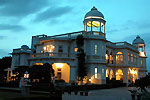|
|
|
|
|
|
|
|
|
|
|
|
|
|
|
|
|
|
|
Gujarat Hotels |
|
|
 |
|
|
|
|
Bhuj Attractions |
|
|
|
|
|
The various tourist
attractions in Bhuj are Cenotaphs Complex, Kutch Museum,
Kera, Prag Mahal, Aina Mahal Palace and Lakhpat. |
|
|
|
Kutch
Museum
The Kutch Museum, formerly known as the Fergusson
Museum, was founded by Maharao Khengarji III in 1877
AD. This museum was built by the state engineer Sir
Ferguson, and thus named after him. This museum
remained a private exhibit for the Maharaos till
independence and was renamed as the Kutch Museum. The
Kutch museum is the oldest museum in Gujarat. This
museum is built in the Italian style and located in
picturesque surroundings on the banks of the Hamirsar
Lake. The museum has a large collection of Kshatrapa
inscriptions, various archaeological objects, arms and
specimens of various crafts of the Kutch region. |
 |
|
|
|
|
Cenotaphs Complex
The Cenotaphs Complex or Chattardi was built of red
stones. These tombs were ruined by the successive
earthquakes since 1819. The complex built for Rao Lakha in
1770, is one of the largest and finest complex. This complex
is in the shape of a polygon with balconies and an
intricately carved roof. Some other cenotaphs belongs to Rao
Rayadhan, Rao Desai and Rao Pragmal. These cenotaphs served
as memorial grounds for the royal family.
Kera
Kera is mainly known due to the 10th century old temple of
Lord Shiva. This temple was damaged in the earthquake of
1819. In its original form this temple must be very
beautiful as it can be seen from the remains of this temple.
Prag Mahal
Prag Mahal was constructed by Rao Pragmalji II (1838-76 AD).
Rao Pragmalji appointed a famous architect, Colonel Henry
Saint Wilkins to design Prag Mahal, who had earlier designed
Deccan College, Sasoon Hospital, Ohel David Synagogue. Prag
Mahal took about 10 years to get built at the cost of 20
lakh rupees.
Aina Mahal Palace
Aina Mahal Palace was built by Rao Lakhpatji in 1750 AD.
Aina Mahal is a part of a large palace complex. It is a two
storey building with Darbar Hall, hall of mirrors, and
suites for royal family. In the 18th century, the Rao
Lakhpatji sent a local craftsman Ramsingh Malam to Europe to
perfect his skills in glassmaking, enamelling, tile making
and iron founding. After he returned back, he constructed
the Aina Mahal with the hall of mirrors of Venetian glass.
The Hall of mirror has white marble walls which are covered
with mirrors and gilded ornaments and the floor is lined
with tiles. The design and decoration of the Aina Mahal was
due to the efficiency of Ramsingh Malam. The platform above
the floor is surrounded by a series of fountains operated by
an elaborated system of pumps below a Venetian chandelier.
Aina Mahal is a unique example of an Indian palace built in
the mid-eighteenth century with European influence. |
|
|
|
Lakhpat
Lakhpat is located northwest of Bhuj at a distance
of 170 km. This place can only be reached by road.
Earlier Lakhpat was a prosperous port which yield one
lac koris, (Lac means 1 lakh and kori was a Kutch
monetary unit) and hence named as Lakhpat. This town
was also the home to hundreds of families involved in
fishing and manual labour but now it is an abandoned
town. Since after the Indus river changed its course,
the port dried up. Almost 50 years ago, the town was
home to hundreds of families involved in fishing and
manual labour but now it is an abandoned town. The
tomb is made of black stone, with four arched doors
and its outer walls are decorated with floral motifs.
The inside walls are |
 |
|
|
engraved with passages
from the holy Koran. It also has a Gurudwara (a Sikh place
of worship) and a number of temples. It is not only the
architecture but the stark loneliness and a vast view of
deserted, crumbling houses which make Lakhpat a rare
spectacle. Now, this place is only a barren plain of
limestone rock. It also has a Gurudwara (a Sikh place of
worship) and various temples.
Bhadreshwar
Bhadreshwar, about 36 kms. west along the coast from
Gandhidham was important as an ancient seaport and has a
temple and two mosques. The Jain Temple is attractive where
the main building is surrounded by the small shrines which
together reproduce the shape and form of the temple itself.
The archway leading into the enclosure, added in the mid
12th century shows Islamic influence. The Solah Khambi
Masjid is the famous and one of the important mosque. This
mosque is the only known Islamic structure that existed
before the Muslim conquest. All its original features are
intact. |
|